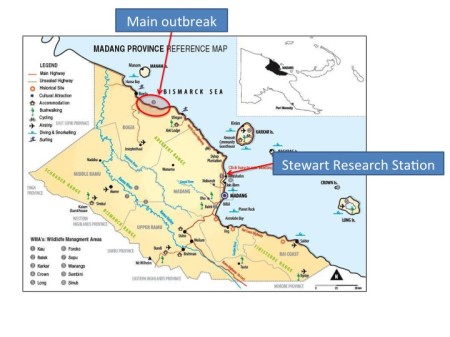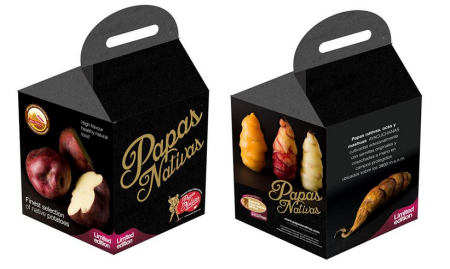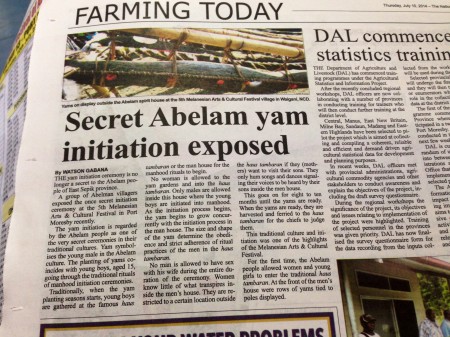- Tending the Field: Special Issue on Agricultural Anthropology and Robert E. Rhoades. Agrobiodiversity conservation, participatory and collaborative research, and the politics of agricultural development.
- Genetic Diversity of Siamese Gourami from Sumatra, Java and Kalimantan for Selective Breeding of Fish Culture. Yeah, but does it taste nice? Time for some fishicultural anthropology, methinks.
- Global to local genetic diversity indicators of evolutionary potential in tree species within and outside forests. You can’t use indirect indicators of pressure, benefit or response independently of state indicators for genetic diversity. Anyway, here’s a bunch of all of those for you to ponder.
- Conventional and phenomics characterization provides insight into the diversity and relationships of hypervariable scarlet (Solanum aethiopicum L.) and gboma (S. macrocarpon L.) eggplant complexes. High-throughput phenotyping platform built for tomatoes distinguishes between really variable complexes of other solanaceous berries.
- Organic vs. conventional farming dichotomy: Does it make sense for natural enemies? Yes.
- Genes are not information: Rendering plant genetic resources untradeable through genetic restoration practices. Decommodify to commodify. No, really.
- Prioritising in situ conservation of crop resources: A case study of African cowpea (Vigna unguiculata). 9 of 13 priority wild cowpea taxa are likely to be found in protected areas.
- Genebanks and genomics: how to interconnect data from both communities? Beyond databases.
The latest on the Bogia Coconut Syndrome
The main reason for my quick trip to Papua New Guinea last week was to get up to date on Bogia Coconut Syndrome (BCS). Readers with a long(ish) memory may remember that we blogged about this some time back. Quick recap. BCS is a phytoplasma disease first reported about 20 years ago in Yaro Plantation, near Bogia, Madang Province, on the northern coast on PNG.
Since then, it has devastated coconuts in a large contiguous area SE of Bogia, but it has also leap-frogged to a number of sites further along the coast towards Madang and beyond. In 2013, it was spotted in Mobdub, which is only a few kilometres from the Stewart Research Station of PNG’s Cocoa & Coconut Research Institute (CCI), home of COGENT’s International Coconut Genebank for the South Pacific (a collection placed under Article 15 of the International Treaty through a tripartite agreement involving the PNG government, Bioversity on behalf of COGENT and FAO). Here’s Alfred Kembu, the curator of the collection, talking about it in a video by Roland Bourdeix, who used to be the coordinator of COGENT, the global coconut network:
https://www.youtube.com/watch?v=wSADJB4tKXEThere are more videos on the disease and the threat it poses to the collection by COGENT and CIRAD. The closest outbreak to the collection is now about 2 km away. There has been a ban in place in Madang for 3 years now on the movement of nuts that have not been de-husked or are sprouting, as the pattern of movement suggests human agency.

At one of these outbreak sites 1, first spotted in 2009, the affected area went from a radius of 200 m in 2011 to 1800 m in 2013; all palms are expected to be dead there within 2-5 years. The disease can kill 1-5 palms per month, meaning that a 1 ha plantation can be destroyed in 4 years. This is an extremely dangerous disease for local smallholders, as well as for the genebank. The same phytoplasma is suspected to affect other palm crops, such as oil palm and betel nut, but also banana and possibly others. This photo shows palms at different stages of development of the disease. In the final stage, nothing but the stem is left.
I went to Madang to take part in the inception workshop of the ACIAR-funded project “Bogia Coconut Syndrome in Papua New Guinea and related phytoplasma syndromes: Developing biological knowledge and a risk management strategy,” which is led by Prof. Geoff Gurr of Charles Sturt University, Queensland, Australia. The project activities, which will last four years, center on intensive and repeated surveying and sampling of both plants and insects in a number outbreak areas (in particular for DNA analysis using “loop-mediated isothermal amplification,” or LAMP, which is apparently a method of identifying phytoplasma DNA which is more efficient and cheaper than standard PCR), followed by a series of transmission experiments.
Although the main output will be basic scientific information on BCS (its causal organism, location in the host plant(s), possible alternate hosts, vector(s) etc, none of these are currently entirely clear), a management plan for the disease will also be devised on the basis of the results. The two-day workshop focused on discussing methodological and logistical issues pertaining to the project, which will involve a number of other PNG institutes apart from CCI, but we also talked about the possible relocation of the germplasm collection to a safer locality. Not quite ready for that yet, but we’ll keep working on it. Here is a shot of part of the collection, by the way: talls on the left, dwarfs on the right, cacao in the understory, which is sold to generate some income to help keep the collection going.
We’ll keep you posted…
If life gives you potatoes…
This from the Facebook page of the Consorcio Papas Andinas del Peru.
The caption says:
Pronto, en los mejores Supermercados de Lima, en una edición limitada, de las mejores papas de los Festivales 2012, 2013 y 2014.
That means that these little boxes, featuring the best varieties from recent National Native Potato Festivals, 2 will soon be available in Lima’s supermarkets. No word on prices, but I suspect some considerable value addition. After all:
Old food the new way — it’s the Peruvian dream of future food.
Yam secrets revealed
I ran across an interesting article in The National newspaper last week in PNG, but I can’t find it online, so I’m posting a scan of it below. You should be able to read it ok if you click on it. It’s worth it. How can anything with the title “Secret Abelam yam initiation exposed” not make for fascinating reading.
The Abelam people are from East Sepik province and their life — especially the life of the men — revolves around yams:
Among the Abelam, the yam cult is a unique cultural institution and the focus of male existence. It involves men striving to produce long tubers (up to a length of 6 feet/180 cm or more), in intense competition with a long term partner in a neighbouring village. There are two major ritual cycles in Abelam life, both centred on this cult — initiation ceremonies which instruct young men in the magic and skills required to grow the prized long yams, and yam growing ceremonies and rituals designed to ensure the success of the current crop.
There are also yam festivals after harvest:
The actual yam displays are very festive occasions. Yam growers from rival villages generally arrive together on the morning of the event. When they are all gathered, the yams, which have been concealed behind barriers and decorated with shell, feather, and basketry ornaments, are carried onto the ceremonial ground. Each waapi is attached to a pole, and carried by two men, one at each end. As the yams are paraded, guests show their approval of their rivals’ efforts by putting special leaves (naarendu) or lime on particularly good specimens. Subsequently the waapi are lined along wooden frames in front of the ceremonial houses where they are carefully inspected and measured by ritual exchange partners. Following the inspection, rivalrous songs, particularly on the themes of yam exchanges and warfare, are sung by individuals. Groups and individuals may claim victory in these song contests by virtue of “evidence” and superior oratory.
It all sounds very spectacular. And extremely important:
…ceremonial yams have an important political function: to a large extent, male status, prestige, and power are dependent on the size and quality of ceremonial yams grown.
In addition to their importance in the political arena, “long yams” have considerable expressive content. Since all yams are propagated vegetatively, yams also form a link between living Abelam men and their ancestors, who planted genetically identical yams. Abelam often invoke their ngwaalndu (clan ancestral spirits) when growing and tending yams. The link between a man, his ceremonial yams, and his ngwaalndu is very close. Yams are of paramount social, symbolic, and religious importance to the Abelam people.
The species involved are Dioscorea alata (waapi) and D. esculenta (jaambe). These are under pressure in some parts of Papua New Guinea, being replaced by recently introduced African species, which seem to withstand pests, diseases and drought somewhat better, I was told. This doesn’t yet seem to be the case for the Abelam, but I wonder for how long. Maybe aeroponics is the answer?
Surviving Typhoon Rammasun
There’s sad news of much damage, and some loss of life, in the wake of Typhoon Rammasun as it travels across the Philippines. You may or may not be able to see this set of photos from Facebook (I don’t understand how permissions work on Facebook) showing some of the effects of the storm on the campus of the University of the Philippines at Los Baños. The area is home to both the national genebank of the Philippines, already much damaged in a previous typhoon, and also the International Rice Research Institute and its global collection. Both collections are substantially duplicated in Svalbard, should anything bad happen. But of course we hope it doesn’t. Our thoughts are with the people of the Philippines.



